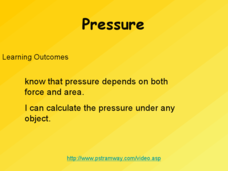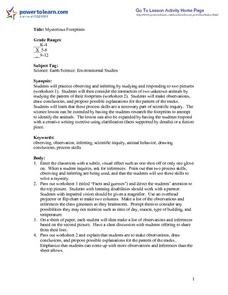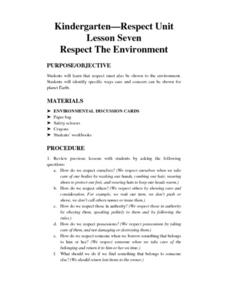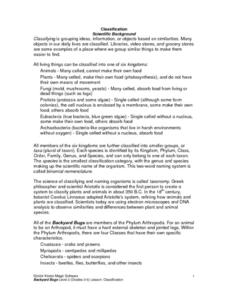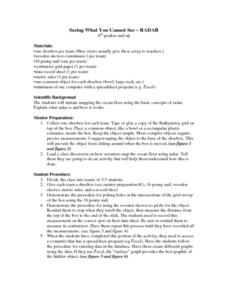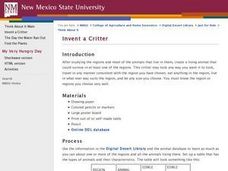Curated OER
Pressure: Pressure Experiment
A short PowerPoint to help increase pupils' understanding of pressure. A number of pictures show different types of shoes and open a discussion of how force from a body is applied over different areas, (which translates into different...
Science 4 Inquiry
The Classification of Living Things
It's a classification sensation! Demystify why we classify using an inquiry activity that helps your class sort things out. Groups begin by classifying a variety of shoes before they research organisms and design their own dichotomous...
Curated OER
Mysterious Footprints
Learners, after observing and responding to two pictures, consider the interaction of two unknown animals by examining the pattern of their footprints. They make observations, draw conclusions and propose possible explanations for the...
Curated OER
Our Natural Resources
Your class will learn about natural resources and man-made items and differentiate between them. They chart resources from seven pictures and explain how each natural resource is used.
Curated OER
Picture Perfect Pyramid
Students investigate the concept of the food pyramid. The lesson includes background information for the teacher to lecture students about the food pyramid. They construct a model of the pyramid using cereal boxes. The projects could...
National Center for Case Study Teaching in Science
A Strange Fish Indeed
Communication is one of the most important aspects of science. In a two-day activity, your high school or college-level biologists will read excerpts from a fictional diary of Marjorie Courtenay-Latimer, the woman who discovered the...
Curated OER
Responses to Changes in the Environment
Fourth graders study ecosystems, and see how plants and animals must adapt to changes in their environment in order to survive. Pictures of the snow shoe hare in the winter and summer are shown. Learners determine that the change in...
Curated OER
Proud to Recycle Worksheet
In this recycling worksheet, learners put a check mark next to the items from a list that are recycled in their local area. They determine which items are curbside recyclables and which are drop-off items. They examine pictures of...
Curated OER
Who Lives with Mallard?
Students color a picture of the habitat featuring mallard and other creatures, some of whom might be camouflaged or half-hidden. They discuss other forms of animal adaptation.
Curated OER
Kindergarten-Respect Unit (Lesson Seven) Respect The Environment
Students review the concept of respect and that they should respect, not only themselves, but those around them. They comment on some example pictures in which the environment is NOT being respected and decide what should have been done...
Curated OER
What Are They Made Of?
After a lesson on scientific materials, your ESL middle schoolers can practice their knowledge by matching nine pictures to their corresponding materials (windows to glass, etc). Additionally, students can compose their own sentences...
Curated OER
Backyard Bugs
Explore the concept of scientific classification and the similarities and differences between plant and animal species. Your class will participate in hands-on activities by investigating dichotomous keys and classifying their shoes. To...
Curated OER
Earth's Biomes
Tenth graders examine characteristics and animals of terrestrial biomes. In this Earth's biomes lesson, 10th graders view a PowerPoint, take noes, sort pictures, research biomes, and create a diorama of a biome for presentation.
Curated OER
Talkin' Trash (All About Landfills)
Students investigate the types of waste created by people and identify various options for trash disposal. They read and discuss a handout about what a landfill is and the different types of trash, match types of trash with the proper...
Curated OER
Seeing What You Cannot See--RADAR
Student imitate mapping the ocean floor using the basic concepts of radar. Then they explain what radar is and how it workds. All of their measurements are recorded on a data sheet. Then the data is entered into a spreadsheet program. A...
Curated OER
Invertebrates
Students examine invertebrates. In this animal classification lesson, students discuss invertebrates and bilateral symmetry. They discuss the importance of horse shoe crabs in medical science.
Polar Trec
Do Microorganisms Live in Antarctica?
Can microorganisms live in the dry, cold climate of Antarctica? Young scientists view a research project measuring microorganisms in the Taylor Glacier. They record the findings from dirty ice, clean ice, boots, sediment, and more. Then...
Curated OER
Sonar Mapping
Students use a shoe box to create a seafloor model and use cardboard for layering inside of the shoe box to simulate the ocean floor. They probe the ocean floor to simulate sonar echoes. Finally, students graph their data to get a...
Curated OER
Volume of Solids
Students engage in a lesson that is concerned with finding the volume of a solid. They investigate and describe the characteristics of a favorite food and identify it as metal or non-metal. The lesson includes pictures of different solid...
Curated OER
Ecologist's Activities
Students construct a model of a biome. In this ecology lesson, students use a shoebox, magazine pictures, paper, and string to create a model biome. Students glue the photos inside the shoe box and draw other objects, such as plants,...
Curated OER
The Solar System
Fourth graders name the planets of the solar system in order from the Sun to Pluto and recognize the planets by pictures shown in class.
Curated OER
Draw a Scientist
Students think to themselves about what a scientist might look like when they're working and then draw a picture of a scientist at work and discuss their drawings. They notice the number of men compared to women and other such...
Curated OER
Seashells of Galveston, Texas
Young scholars take a trip to Galveston's beaches. They collect empty shells, and visit the internet site to identify the seashells they find. Students visit the linked websites to view pictures of seashells and aid in their...
Curated OER
Invent a Critter
Students create a living animal that could survive in at least one specific region and use the digital desert library to gather information. In this invent a critter lesson, students draw a picture of their animal, describe their...
